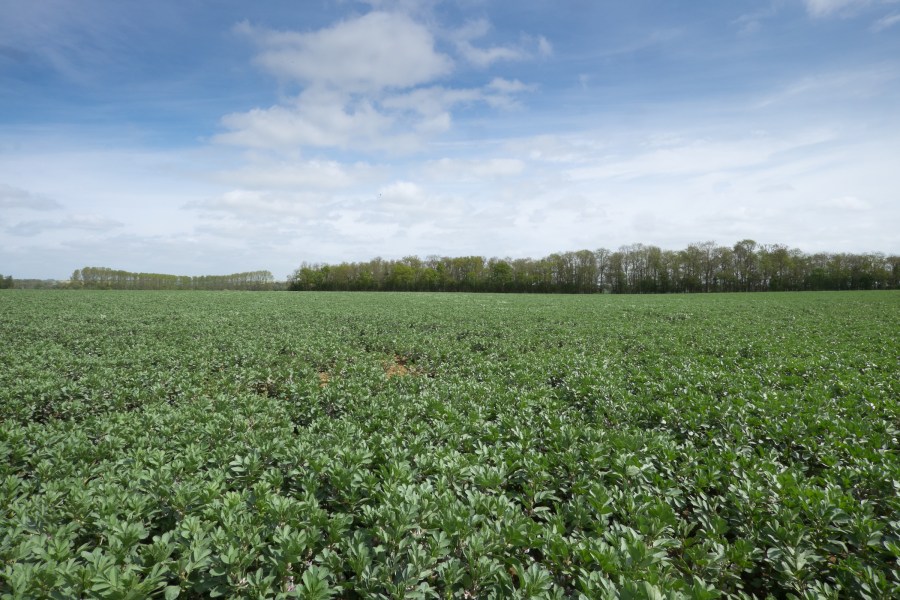The latest PGRO crop update has highlighted the presence of yield robbing pests and diseases such as pea and bean weevil, downy mildew, chocolate spot and Cercospora. So how can growers best monitor and treat them? CPM reports.
Pea and bean weevils have been found in traps in Cambridgeshire and at sites monitored by the Rothamsted Insect Survey, due to the warm weather in late February.
To keep an eye on weevil presence, a monitoring system is available to farmers, which detects adults as they migrate in early spring, consisting of five cone traps containing pheromone lures. It can be used to aid decision-making in the following ways:
- Identifies seasons when weevil numbers are low and crops do not require treatment.
- Identifies peak activity and best timing of applications.
- Reduces the need for prophylactic spraying.
- May allow drilling time to be changed to avoid peak weevil activity.
Traps should be sited on a grass margin or headland of a field cropped with peas or beans in the previous year and should be checked three times each week.
A threshold is reached when an average of more than 30 weevils is recorded per trap on any one occasion.
When a threshold is reached, any crops that have just emerged or are likely to emerge within 10 days are likely to be at risk. Insecticides should be applied at first signs of crop damage, seen as u-shaped notching on leaf edges, especially where there is a history of severe damage.
A second spray may be required if crops are growing slowly.
If a threshold is not reached or occurs more than 10 days before crop emergence, insecticides are not required. Winter beans rarely require treatment as they are well established before attack occurs.
Traps are available from Agralan Ltd: https://www.agralan-growers.co.uk/
Other diseases
There have also been reports of downy mildew, chocolate spot and Cercospora in winter beans, so what are the symptoms to watch out for?
Downy mildew
Downy mildew can be severe in field beans but often doesn’t warrant treating in winter beans.
Characteristic symptoms include pale patches on the upper surface of leaves with a greyish-mauve, velvety growth on the underside.
The growing points may be chlorotic and distorted and pod set can be reduced. The disease is favoured by cool, humid conditions.
Treatment should be applied when lesions can be found on about 25% of plants and the crop has started flowering. Straight Metalaxyl-M (SL567A) can be used on field beans (EAMU 0917/13).
Chlorothalonil + metalaxyl-M is available for broad beans only.
Several spring bean varieties are resistant to infection, a full list can be found at: http://www.pgro.org/downloads/A4-rec-list-2019.pdf
Chocolate spot
Chocolate spot is encouraged by long periods of overcast and wet weather.
Winter beans are more susceptible to infection, especially where plant populations are high, while spring and broad beans can develop chocolate spot during wet spring and summer conditions.
The disease develops as small, circular, chocolate coloured spots on the lower leaves. These become larger and may coalesce to form a greyer coloured lesion extending over the leaf surface. Stems and pods can also develop a covering of spots or flecks.
Severe infections can result in defoliation and protectant fungicides should be applied at first pod if spotting is seen on the leaves.
If severe spotting is seen earlier in the season, the first spray should be moved forward. A second spray should be applied 3-4 weeks later if spotting continues to develop on the upper parts of the plant.
Cercospora leaf spot
Cercospora leaf spot has been reported more frequently in UK field beans in the past few years and there have been reports in winter beans in early 2019.
The disease persists in crop residues and is dispersed by wind and rain to infect young plants, particularly in fields planted close to previous year’s crops.
Symptoms are similar to those displayed by Ascochyta, but no pycnidia are present at the centre of lesions. Lesions are dark brown to black with a grey centre, and with a characteristic zonal pattern.
Products containing tebuconazole or chlorothalonil are effective against the disease.




